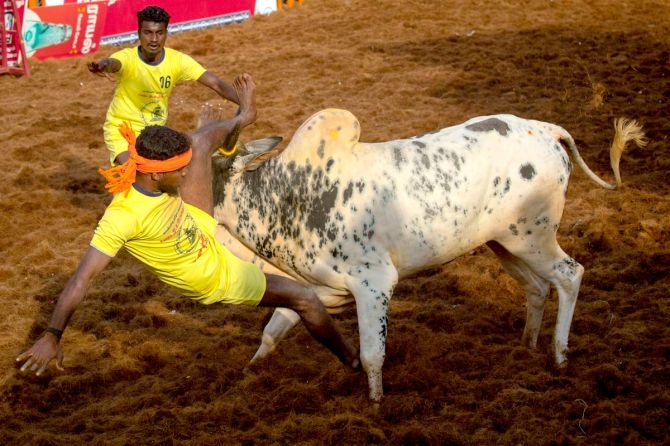The Lok Sabha polls could be a testing time for the state, as religious and caste divisions get accentuated disproportionately, alerts N Sathiya Moorthy.

Unlike what a section of the BJP leaders in Tamil Nadu are hinting at, Wednesday's hurling of a 'Molotov cocktail' on the Chennai Raj Bhavan prima facie seems to be a 'lone wolf' act without any link to any terrorist or militant group.
According to the police, the man, M Vinod or 'Karukka' Vinod, is a history-sheeter or 'known delinquent', out on bail after throwing petrol bombs on other targets also in the city, was in an inebriated condition and was promptly arrested by the policemen on duty at the Raj Bhavan.
The issue assumes significance not because of the so-called attack.
No one was injured and the petrol bomb that Vinod threw from a distance did not go anywhere near the Raj Bhavan gates, beyond which deep inside is the official and residential quarters of Governor R N Ravi and his staff.
Instead, it owes to the unending run-ins between the governor and Chief Minister M K Stalin's DMK state government.
The latest was Ravi's more recent talk that there was nothing by way of an Aryan-Dravidian divide in the country until the British colonisers divined one as a part of their divide-and-rule policy.
Immediately before it, he had declined the state cabinet's recommendation to name recently-retired DGP, C Sylendra Babu, as chairman of the Tamil Nadu Public Service Commission, citing procedural flaws.
Sylendra Babu, along with then chief secretary V Iraianbu, is among the few civil servants in the state known for going out of their way to prepare the younger generation for appearing in UPSC exams.
This, they used to do even in the midst of their busy schedule in high positions, from the lower ranks all the way up to the top.
The governor's 'rejection' of Sylendra Babu's nomination to the TNPSC post has caused eyebrows to raise across the board, especially among the state's aspiring youth intent on a civil service career, either at the centre or in the state.
Then there is the case of Governor Ravi as chancellor declining the Madurai-Kamaraj University authorities' recommendation for conferring a honorary doctorate on freedom-fighter and veteran Marxist centenarian, N Sankaraiah.
It is rare to have a freedom fighter living in our midst at the ripe age of 100.
This decision of Ravi's too did not go down well as he and the BJP with which he has got identified with have been indicating their disapproval of what they say is the DMK state government not doing enough for the memory of freedom fighters.
Though it may be too much to blame the state government or the city police for a lone man hurtling a petrol bomb at the Raj Bhavan, ands though he may not have any political leanings, state BJP president K Annamalai and his team have begun attributing motives to the attack.
Some of them have even demanded a National Investigation Agency (NIA) probe, as if it were a 'terrorist attack', which alone is in their purview under a special law for the purpose.
Yet, there is no denying a larger socio-political climate over the past several years and decades, in which militant trends have grown, in different forms and for varying reasons.
For a politically aware, socially progressive and economically successful state, Tamil Nadu may have also been sitting on a tinder-box of multiple extremisms prone to violence -- and for long.
It is seldom understood to be acknowledged. Blame it on social and societal enlightenment or whatever, every known form of militancy is present, if not prevalent in the state.
Tamil Nadu is possibly the only state in the country where all forms of militancy exist.
Here, ideological, ethnic, religious and caste violence vie for socio-political space alongside once-active labour disputes and strikes with or without violence.
While ethnic protests are still prevalent, there is not much violence on that score.
Ideologically-oriented Left militancy is on the decline for long, there are yet periodic reports about 'urban Naxals'.
At times, it involves weapons-training in the forest areas of the state's southern districts. The trainees are mostly from eastern states like Odisha but the police have arrested locals too.

There is no visible decline in the incidence of religious violence, invariably involving Islamic terrorists on the one hand and Hindutva agitators on the other.
More than violence involving the two groups, it is their periodic arrests, respectively by the NIA and the state police that make news.
Caste violence in Tamil Nadu takes two distinct forms, as elsewhere -- one, group clashes and other, 'honour killings'.
Both are to be abhorred, yes, but for an enlightened state like Tamil Nadu to figure in the list shows that something is still amiss in matters of social re-engineering that the Dravidian polity and people are so proud of.
Labour disputes, which have become few and far between compared to the previous century, occasionally end up in bloody incidents -- often out of media coverage.
Gone are the days when bank and insurance employees would join hands with rail men and private factory labour to choke roads and streets in massive street protests that could hang on for days and weeks.
Unlike their parental generation, the current crop does not want their children in upmarket schools to see them on television, and for the 'wrong reasons'.
One can blame the state's relative enlightenment to the decreasing incidence of violent streaks in the society in recent years -- and at the same time, their expansion, too.
Both national and global studies have shown that more educated and 'enlightened' a societal group becomes, greater are the chances of fringe elements from among them taking to militancy, to achieve their indistinct goals -- or, at least to make a point or send out a message.
That triggers a cyclic reaction, to which there is no end.
A new trend, a safe side of this 'social enlightenment', is the increasing use of social media for messaging to a larger and more open constituency.
The outcome is also as passive as the methodology, making it difficult to conclude, which of them -- the mode or the means -- influenced and guided the other.
The pro-Jallikattu protest of January 2017 was a marker, which the rest of the nation could not ignore.
The younger generation in the state and elsewhere at least had not seen anything close to it, in terms of reach and outreach, with the reach following IT-enabled outreach.
If a million people gathered in capital Chennai's Marina beach for a week and more, as if on cue when no identifiable leadership of any kind existed -- then or since -- thousands more gathered in every town and village, across the state, likewise.
Possibly inspired by democratic demonstrations in many countries across the world in the previous years, starting with 'Arab Spring' and 'Orange Revolution', the Jallikattu protest is believed to have been an additional inspiration for the anti-government Aragalaya protests in neighbouring Sri Lanka last year.
The underpinning common line related to basic issues, the larger concerns they flagged and the methodology of mass protests, which all of them employed.
The parallels did not end there. In Sri Lanka and elsewhere, the protestors did enjoy the support of local law-enforcers, starting at times at the very top.
Barring less than a handful of policemen who supported the Jallikattu protests on social media, including YouTube, the Tamil Nadu police was on the side of enforcing law.
From beginning to end, their leadership was flummoxed by what essentially was a Gandhian protest, by a generation far removed from the man and his mission in every which way.

More recent international inspirations apart, the Jallikattu protests may have had their origins in the local anti-government demonstrations of the kind, in villages and towns and cities across the state over the previous three decades.
The first possible urban incident of the kind was when residents of suburban Perambur in capital Chennai (then Madras) impromptu marched about 12 km in scorching sun, over drinking water shortage, to chief minister M Karunanidhi in his Gopalapuram residence, just a day after he had returned to power as far back as 1996.
Very many protests of the kind, big and small, by farmers, bus passengers, hospital-users, and occasionally students, went mostly unreported from across the state.
The noticeable return of organised protests was the one launched by Left-leaning quasi-militant women organisations outside liquor shops, asking the then Jayalalithaa government to re-introduce total prohibition during the year-long run-up to the 2016 assembly elections.
The death of 59-year-old Sasi Perumal while protesting from atop a mobile tower in Kanyakumari district did provide fillip to the state-wide protests, but they did not produce the desired results.
Yet, there is no denying the limited success of their mission, as Jaya returned to power, post-poll.
However, the Jayalalithaa government first, and successor administrations including the incumbent DMK dispensation of Chief Minister Stalin, could not but shut down a few hundred government-run TASMAC outlets and bars, every now and again.
Though poor returns may be among the reasons, there is no denying greater bureaucratic sensitivity to locating liquor outlets near schools or places of worship and other crowded thoroughfares.
The Supreme Court's directions in the matter have helped, yet, there is still the unending possibility of a constant flare-up of pro-prohibition protests, anytime, anywhere in the state.

Over the short-term, the upcoming Lok Sabha polls could be a testing-time for the state, as religious and caste divisions especially get accentuated disproportionately.
It requires greater coordination between the Centre and state government and their agencies in matters of internal security.
This is particularly so when it comes to acts of terror, where the NIA, for instance, operates in a silo-style, reportedly not always sharing information with the state police.
Last year, a person earlier interrogated by the NIA ended up being the main perpetrator of the Coimbatore car blast, but it turned out that the state police did not have any information/instruction to keep tabs on the man.
The reverse is also true on occasions, but mostly in the past.
In the long term, there are issues and issues that are dear to the state's population but about which there is little or no sensitivity elsewhere in the country, starting with the Centre.
Of particular concern are the Cauvery water issue with Karnataka, the Mullaperiyar row with Kerala and the 'fishers issue' with Sri Lanka, where non-State players these past weeks reportedly beat up TN fishers, robbed their catch and destroyed their gear.
In some cases, fishers who violate the International Maritime Boundary Line and poach in Sri Lankan waters are also handed over to the local police, like the Sri Lanka Navy has been doing all along.
They also 'arrest' their bottom trawlers that are left to rot in sun and rain until they become unserviceable even if returned to legal owners.
These are all live issues with potential for dramatic revival at any time as underlying emotions swell up and burst out, in contexts other than those intended -- as with the Jallikattu protests.
These are all livelihood issues that affect a particular segment of the state's population, but whose effects are felt by all.
Then there are larger, hyper-sensitive issues of language and culture, where religion is seeking to find a place in the over-crowded politico-electoral space.
The language-culture issues collude at some points and collide at others.
The outcome is both complex and complicated.
In Dravidian Tamil Nadu where religion and religious symbols were always a socio-political issue with little to go by way of electoral space, current attempts to de-mystify religion into an electoral tool, as elsewhere in the country, can have unpredictable consequences.

In the midst of it all, there is the unsaid apprehension of Tamil Nadu losing the maximum number of eight of 39 Lok Sabha seats after the national census, shifted from 2021 to 2026.
While political parties and social organisations are bound to rake up the issue in a big way when it happens, peripheral pan-Tamil groups of multi-hues and multiple identities are already resorting to an occasional social media drum-beating in support of a cause that is yet to take shape.
How it pans out will depend on how sensitive the Centre is to the issue when the 2026 census is followed by de-limitation of Lok Sabha constituencies, whose total numbers too are expected to go up.
But there are definitely undercurrents that need to be understood and the attendant concerns addressed.
For, the possible loss of Lok Sabha seats is already being interpreted as penalising the state for decades-old success on the population front.
There is then the on-again, off-again discontentment, expressed by political parties even more, over what is seen as further 'punishing' the state's people more through NEET-like measures, and imposition of 'outsiders' in white-collar jobs in central departments and undertakings like the Railways, banks and insurance companies.
This is at a time when the state has been absorbing non-Tamils in their tens of thousands in lesser jobs.
In earlier generations, these sectors had provided the wherewithal and exposure, for them to educate their children to levels that most of them are now engineers and doctors, management gurus and IT professional, who thronged the Jallikattu protest sites in their thousands.
The same way, 'migrant labour' are likely to educate their children in the state, in the coming years and decades.
N Sathiya Moorthy, veteran journalist and author, is a Chennai-based policy analyst and political commentator.
Feature Presentation: Aslam Hunani/Rediff.com










